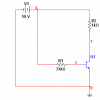Hi.
I'm looking at an example in a book which gives this circuit. The beta is given as
20. It says to calculate Ib, it's 10V - vbe = 9.3/33K = 282uA.
It then says to calculate Ic, it's Ib * beta = 282uA * 20 = 5.6mA. Now you can calculate Vrc which is 5.6mA * 1k = 5.6V.
Is the book right? Isn't that saying that regardless of Rc, the current will be Ib * beta. What happens if Rc is a lot bigger? Thanks in advance.
I'm looking at an example in a book which gives this circuit. The beta is given as
20. It says to calculate Ib, it's 10V - vbe = 9.3/33K = 282uA.
It then says to calculate Ic, it's Ib * beta = 282uA * 20 = 5.6mA. Now you can calculate Vrc which is 5.6mA * 1k = 5.6V.
Is the book right? Isn't that saying that regardless of Rc, the current will be Ib * beta. What happens if Rc is a lot bigger? Thanks in advance.
Attachments
Last edited:


